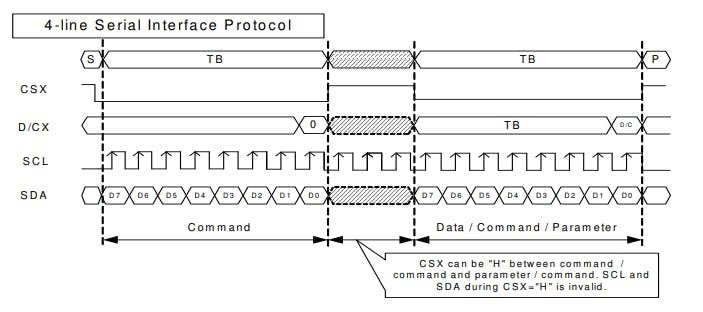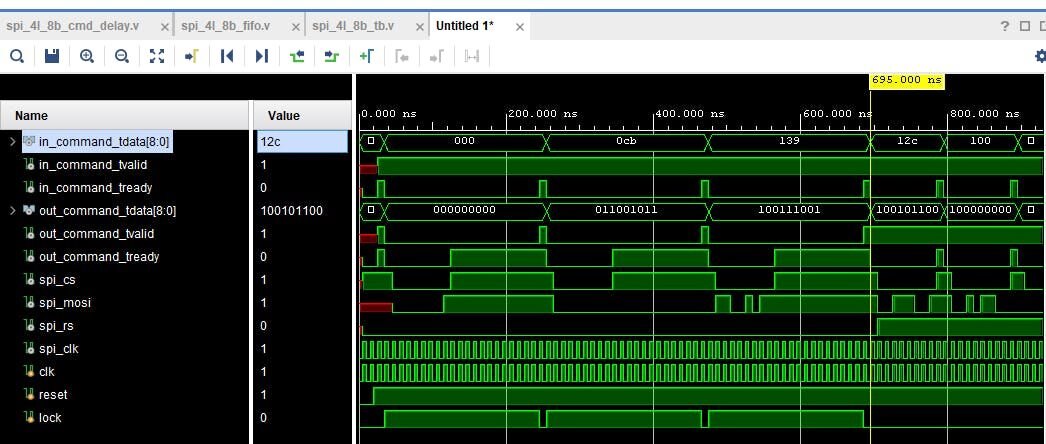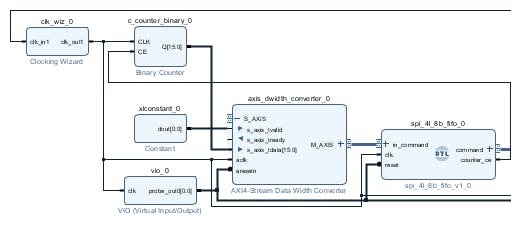| {gallery}Vivado project creation |
|---|
|
|
|
|
|
|
|
|
|
|
-
CS - chip select (CSX)
-
RS - register select (D/CX)
-
CLK - spi clock (SCL)
-
MOSI - master output slave input (SDA)

-
When CS is high, all commands and parameters are ignored
-
We are starting the transition by holding CS in low state
-
At the next positive edge of the SCL, the oldest bit - D7 is being sampled, then on the next edge D6 etc...
-
On the last bit of the byte - D0, the driver also samples D/CX signal. Before that, D/CX is ignored.
module spi_4l_8b(
input [8:0]command_tdata,
input command_tvalid,
output reg command_tready,
output reg spi_cs,
output reg spi_mosi,
output spi_rs,
output spi_clk,
input clk,
input reset
);
reg data_locked = 0;
reg [8:0] command = 0;
reg [3:0] command_bit_counter = 7;
assign spi_clk = clk;
assign spi_rs = command[8];
always @(posedge clk) begin
if (!reset) begin
data_locked <= 0;
command <= 0;
command_tready <= 0;
command_bit_counter <= 7;
spi_cs <= 1;
end else begin
if (!data_locked) begin: wait_for_transaction
spi_cs <= 1;
if (command_tready && command_tvalid) begin
command <= command_tdata;
command_tready <= 0;
data_locked <= 1;
end else begin
command_tready <= 1'b1;
end
end else begin
spi_cs <= 0;
spi_mosi <= command[command_bit_counter];
if (!command_bit_counter) begin: send_spi_data
command_bit_counter <= 7;
data_locked <= 0;
end else begin
command_bit_counter <= command_bit_counter - 1;
end
end
end
end
endmodule
module spi_4l_8b_cmd_delay
#(parameter delay_val = 500000)(
output [8:0]out_command_tdata,
output out_command_tvalid,
input out_command_tready,
input [8:0]in_command_tdata,
input in_command_tvalid,
output in_command_tready,
input clk,
input reset
);
reg [31:0] delay_counter = 0;
reg lock = 0;
assign out_command_tdata = in_command_tdata;
assign out_command_tvalid = in_command_tvalid && (!lock);
assign in_command_tready = out_command_tready && (!lock);
always @(posedge clk) begin
if (!reset) begin
delay_counter <=0;
lock <= 0;
end else begin
if (
!in_command_tdata[8] && //If incoming data is command
(in_command_tdata[7:0] != 8'b0010_1100) && //If command is not screen write
out_command_tready && //If AXI4 transaction
in_command_tvalid && //passes
!lock // and IP is not already locked.
) begin
lock <= 1;
delay_counter <= delay_val;
end else if (!delay_counter) begin
lock <= 0;
end
if (delay_counter) begin: decrement_delay_counter
delay_counter <= delay_counter - 1;
end
end
end
endmodule
-
First, after reset, initialize LCD with default values.
-
Second, send memory write command to LCD after 240x320 pixels.
-
Third, parse the incoming 8-bit stream into 9-bit SPI commands.
`define ili_NOP 8'h00 // No Operation - NOP
`define ili_SWRESET 8'h01 // Software Reset - SWRESET
`define ili_SLPOUT 8'h11 // Sleep Out
`define ili_GAMSET 8'h26 // Gamma Set
`define ili_DISPOFF 8'h28 // Display OFF
`define ili_DISPON 8'h29 // Display ON
`define ili_CASET 8'h2A // Column Address Set
`define ili_PASET 8'h2B // Page (row) Address Set
`define ili_RAMWR 8'h2C // Memory Write
`define ili_MADCTL 8'h36 // Memory Access Control
`define ili_IDMOFF 8'h38 // Idle Mode OFF
`define ili_IDMON 8'h39 // Idle Mode ON
`define ili_PIXSET 8'h3A // COLMOD: Pixel Format Set
`define ili_RAMWRCont 8'h3C // Write Memory Continue
`define ili_FRMCTR1 8'hB1 // Frame Rate Control (In Normal Mode/Full Colors)
`define ili_DISCTRL 8'hB6 // Display Function Control
`define ili_PWCTRL1 8'hC0 // Power Control 1
`define ili_PWCTRL2 8'hC1 // Power Control 2
`define ili_VMCTRL1 8'hC5 // VCOM Control 1
`define ili_VMCTRL2 8'hC7 // VCOM Control 2
`define ili_PGAMCTRL 8'hE0 // Positive Gamma Correction
`define ili_NGAMCTRL 8'hE1 // Negative Gamma Correction
`define ili_PCA 8'hCB // Power Control A
`define ili_PCB 8'hCF // Power Control B
`define ili_DTCA_ic 8'hE8 // Driver Timming Control A
`define ili_DTCB 8'hEA // Driver Timming Control B
`define ili_POSC 8'hED // Power On Sequence Control
`define ili_E3G 8'hF2 // Enable 3G
`define ili_PRC 8'hF7 // Pump Ratio Control
module spi_4l_8b_fifo
#(parameter MEMORY_LIMIT = 96) // Nb of init commands
(
input [7:0]in_command_tdata,
input in_command_tvalid,
output reg in_command_tready,
output [8:0]command_tdata,
output reg command_tvalid,
input command_tready,
output reg counter_ce,
input clk,
input reset
);
reg [8:0] memory[MEMORY_LIMIT - 1:0];
reg [18:0] memory_counter = 0;
reg [8:0] output_reg = 0;
localparam INIT = 0;
localparam NEXT_FRAME = 1;
localparam SEND_FRAME = 2;
localparam LCD_SIZE = 153600; //240x320*2 -> 2 transactions per pixel.
reg [1:0]state = INIT;
integer i;
task tft_write (input [7:0] cmd, input type);
begin
memory[i] = {type, cmd};
i = i + 1;
end
endtask
task write_data8 (input [7:0] cmd);
begin
tft_write(cmd, 1'b1);
end
endtask
task write_cmd (input [7:0] cmd);
begin
tft_write(cmd, 1'b0);
end
endtask
task write_data16(input [7:0] cmd1, input [7:0] cmd2);
begin
write_data8(cmd1);
write_data8(cmd2);
end
endtask
task delay();
begin
tft_write(8'h00, 1'b0);
end
endtask
initial begin
i = 0;
write_cmd(`ili_SWRESET);
write_cmd(`ili_NOP);
// Power Control A
write_cmd(`ili_PCA);
write_data8(8'h39);
write_data8(8'h2C);
write_data8(8'h00);
write_data8(8'h34);
write_data8(8'h02);
// Power Control B
write_cmd(`ili_PCB);
write_data8(8'h00);
write_data8(8'hC1);
write_data8(8'h30);
// Driver Timming Control A
write_cmd(`ili_DTCA_ic);
write_data8(8'h85);
write_data8(8'h00);
write_data8(8'h78);
// Driver Timming Control B
write_cmd(`ili_DTCB);
write_data8(8'h00);
write_data8(8'h00);
// Power On Sequence Control A
write_cmd(`ili_POSC);
write_data8(8'h64);
write_data8(8'h03);
write_data8(8'h12);
write_data8(8'h81);
// Pump Ratio Control
write_cmd(`ili_PRC);
write_data8(8'h20);
// Power Control 1
write_cmd(`ili_PWCTRL1);
write_data8(8'h23);
// Power Control 2
write_cmd(`ili_PWCTRL2);
write_data8(8'h10);
// VCOM Control 1
write_cmd(`ili_VMCTRL1);
write_data8(8'h3E);
write_data8(8'h28);
// VCOM Control 2
write_cmd(`ili_VMCTRL2);
write_data8(8'h86);
// Memory Access Control
write_cmd(`ili_MADCTL);
write_data8(8'hA8);
// Pixel Format Set
write_cmd(`ili_PIXSET);
write_data8(8'h55);
// Frame Rate Control
write_cmd(`ili_FRMCTR1);
write_data8(8'h00);
write_data8(8'h18);
// Display Function Control
write_cmd(`ili_DISCTRL);
write_data8(8'h08);
write_data8(8'h82);
write_data8(8'h27);
// Enable 3G
write_cmd(`ili_E3G);
write_data8(8'h00);
// Gamma Set
write_cmd(`ili_GAMSET);
write_data8(8'h01);
// Positive Gamma Correction
write_cmd(`ili_PGAMCTRL);
write_data8(8'h0F);
write_data8(8'h31);
write_data8(8'h2B);
write_data8(8'h0C);
write_data8(8'h0E);
write_data8(8'h08);
write_data8(8'h4E);
write_data8(8'hF1);
write_data8(8'h37);
write_data8(8'h07);
write_data8(8'h10);
write_data8(8'h03);
write_data8(8'h0E);
write_data8(8'h09);
write_data8(8'h00);
// Negative Gamma Correction
write_cmd(`ili_NGAMCTRL);
write_data8(8'h00);
write_data8(8'h0E);
write_data8(8'h14);
write_data8(8'h03);
write_data8(8'h11);
write_data8(8'h07);
write_data8(8'h31);
write_data8(8'hC1);
write_data8(8'h48);
write_data8(8'h08);
write_data8(8'h0F);
write_data8(8'h0C);
write_data8(8'h31);
write_data8(8'h36);
write_data8(8'h0F);
// Sleep Out
write_cmd(`ili_SLPOUT);
write_cmd(`ili_NOP);
//Display ON
write_cmd(`ili_DISPON);
write_cmd(`ili_NOP);
write_cmd(`ili_CASET);
write_data8(8'h00);
write_data8(8'h00);
write_data8(8'h01);
write_data8(8'h40);
write_cmd(`ili_PASET);
write_data8(8'h00);
write_data8(8'h00);
write_data8(8'h00);
write_data8(8'hEF);
//Init Done
end
always @(posedge clk) begin
if(!reset) begin
memory_counter <= 0;
counter_ce <= 0;
state <= INIT;
end else begin
case (state)
INIT: begin
counter_ce <= 0;
command_tvalid <= 1;
if (command_tvalid && command_tready) begin
memory_counter <= memory_counter + 1;
end
if (memory_counter == MEMORY_LIMIT) begin
state <= NEXT_FRAME;
command_tvalid <= 0;
end
end
NEXT_FRAME: begin
memory_counter <= 0;
command_tvalid <= 1;
if (command_tvalid && command_tready) begin
state <= SEND_FRAME;
command_tvalid <= 0;
counter_ce <= 1;
end
end
SEND_FRAME: begin
counter_ce <= 0;
in_command_tready <= command_tready;
command_tvalid <= in_command_tvalid;
if (in_command_tready && in_command_tvalid) begin
memory_counter <= memory_counter + 1;
end
if (memory_counter >= LCD_SIZE - 1)
state <= NEXT_FRAME;
end
default: begin
state <= INIT;
memory_counter <= 0;
end
endcase
end
end
assign command_tdata = state == INIT ? memory[memory_counter] : state == NEXT_FRAME ? {1'b0, `ili_RAMWR} : {1'b1, in_command_tdata};
endmodule

`timescale 1ns / 1ns
module spi_4l_8b_tb;
wire [8:0]in_command_tdata;
wire in_command_tvalid;
wire in_command_tready;
wire [8:0]out_command_tdata;
wire out_command_tvalid;
wire out_command_tready;
wire spi_cs;
wire spi_mosi;
wire spi_rs;
wire spi_clk;
reg clk = 0;
reg reset = 0;
reg [7:0] acu = 8'hFF;
reg acu_vld = 1'b1;
wire sink;
wire counter_ce;
spi_4l_8b_fifo u0_spi_4l_8b_fifo(
.in_command_tdata(acu),
.in_command_tvalid(acu_vld),
.in_command_tready(sink),
.command_tdata(in_command_tdata),
.command_tvalid(in_command_tvalid),
.command_tready(in_command_tready),
.counter_ce(counter_ce),
.clk(clk),
.reset(reset)
);
spi_4l_8b_cmd_delay #(.delay_val(20))
u0_spi_4l_8b_cmd_delay(
.out_command_tdata(out_command_tdata),
.out_command_tvalid(out_command_tvalid),
.out_command_tready(out_command_tready),
.in_command_tdata(in_command_tdata),
.in_command_tvalid(in_command_tvalid),
.in_command_tready(in_command_tready),
.clk(clk),
.reset(reset)
);
spi_4l_8b u0_spi_4l_8b (
.command_tdata(out_command_tdata),
.command_tvalid(out_command_tvalid),
.command_tready(out_command_tready),
.spi_cs(spi_cs),
.spi_mosi(spi_mosi),
.spi_rs(spi_rs),
.spi_clk(spi_clk),
.clk(clk),
.reset(reset)
);
always begin #5 clk = !clk; end
initial begin
#20 reset = !reset;
$monitor("New data_in: %h %0t", u0_spi_4l_8b.command, $time);
end
endmodule####################################################################### # Pmod #1 ####################################################################### set_property PACKAGE_PIN L14 [get_ports spi_rs] set_property IOSTANDARD LVCMOS33 [get_ports spi_rs] set_property PACKAGE_PIN K13 [get_ports spi_cs] set_property IOSTANDARD LVCMOS33 [get_ports spi_cs] set_property PACKAGE_PIN L13 [get_ports spi_mosi] set_property IOSTANDARD LVCMOS33 [get_ports spi_mosi] set_property PACKAGE_PIN N14 [get_ports spi_clk] set_property IOSTANDARD LVCMOS33 [get_ports spi_clk]
| {gallery}block design |
|---|
|
|
|
|
|
|
| {gallery}Block design Ips |
|---|
|
|
|
|
|
|
|
|
|
|
|
|
|
|
| {gallery}Program minized |
|---|
|
|
|
|
|
|

